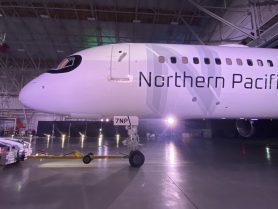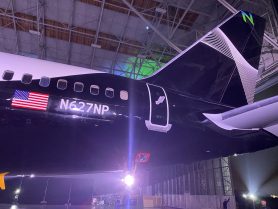Tuesday evening saw a significant milestone in Northern Pacific Airways’ path to launch, as they unveiled their first aircraft at a paint hangar in San Bernardino, California. Touting “the next era in travel,” Northern Pacific Airways is molding their clay to connect several major US cities to Asia, with a stopover in Anchorage, Alaska, utilizing a fleet of Boeing 757-200 aircraft.

The forward end of the Boeing 757
Sporting “raccoon mask” paint around the windscreen which is all the rage with newer-designed aircraft, and showing off a super glossy finish along its fuselage, one wonders if this is what a re-engined “757 MAX” might have looked like if Boeing hadn’t ceased production when they did.
After most airlines retired or began a phase-out of the 757 from their fleets, the type has been seeing a common second life in cargo operations. So how did the 757 land at NPA’s passenger outfit?
Their first airplane is registered N627NP. Nearing its 27th birthday, it was delivered to USAir in 1995 as N630AU, was later re-registered as N206UW, and then became an asset of American Airlines after the completion of their merger in 2015. The COVID-19 pandemic accelerated American Airlines’ plans to retire the Boeing 757-200, so when aircraft sales and leasing company Aersale grabbed up several of them, it gave the opportunity for Northern Pacific to obtain what is still a very capable airplane.

The tail of the aircraft, showing the N627NP registration.
Though an older type with its last airframe rolling off of the line in 2004, the 757 can still give new aircraft like the 737 MAX 10 and the Airbus A321XLR a run for their money in terms of range, payload capacity, and even outpacing them in terms of takeoff performance and operations on wet runways. Often referred to as “over-powered,” the strong performance of the 757 may be exactly what the doctor ordered for Northern Pacific Airways’ narrowbody long haul plans. Of course, economics plays a large role.
“We look at the 757 as not “Mr. Right” but “Mr. Right Now,” explained CEO Rob McKinney. For all of its advantages, the 757’s age, and its Rolls-Royce RB211 engines, are the variables that affect the bottom line. Although the inventory of the aircraft type is reliable enough for NPA’s plans to own a dozen by launch and work their way up to their goal of operating as many of 50 of the type, the fuel burn of the aircraft puts it nowhere near the Prius of the skies. Thankfully, the 757 being increasingly common in cargo and their engine being used in many places gives Northern Pacific the chance to keep aircraft maintenance costs somewhat manageable until newer aircraft become more readily available, including consideration for widebodies.

A mockup of the Northern Pacific seats, showing both business class and economy.
The interior has a sea of black, vegan leather seats wearing classy stitching that reflects a mountain and glacier abstract. NPA will offer 3 rows of 2×2 business seating and 176 economy seats in the remainder of the cabin. Service will include a variety of products from PepsiCo and Brown-Forman.
Frequently compared to the Icelandair of the Pacific, the model Northern Pacific is aiming for is tried and true when you look at not just the 757, but having an oceanic mid-point for passengers to either switch aircraft or get off to enjoy a location that is a great destination in itself. McKinney explained his frustration at the number of flights to Asia that overfly Anchorage, forcing Alaskans to fly to Seattle to change flights to backtrack across the Pacific.
McKinney also said they were striking while the fire is hot with the availability of slots and gates at a premium cost.
With plans to begin service in the second half of 2022, Northern Pacific’s operations is still “pending government approval.” They intend to serve cities in the states of New York, Florida, California, Texas, and Nevada, with direct flights to cities in Japan and Korea, all of which connect in Anchorage, Alaska.
Read more about the airline at np.com.

